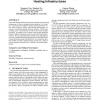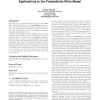113
Voted
PODC
2010
ACM
15 years 4 months ago
2010
ACM
Consider an n-vertex graph G = (V, E) of maximum degree ∆, and suppose that each vertex v ∈ V hosts a processor. The processors are allowed to communicate only with their neig...
86
Voted
PODC
2010
ACM
15 years 4 months ago
2010
ACM
Wait-freedom and obstruction-freedom have received a lot of attention in the literature. These are symmetric progress conditions in the sense that they consider all processes as b...
PODC
2010
ACM
15 years 4 months ago
2010
ACM
An effective way to reduce the number of aborts in software transactional memory (STM) is to keep multiple versions of transactional objects. In this paper, we study inherent prop...
PODC
2010
ACM
15 years 4 months ago
2010
ACM
: The Borowsky-Gafni (BG) simulation algorithm is a powerful reduction algorithm that shows that t-resilience of decision tasks can be fully characterized in terms of wait-freedom....
92
Voted
PODC
2010
ACM
15 years 4 months ago
2010
ACM
We study the problem of clock synchronization in highly dynamic networks, where communication links can appear or disappear at any time. The nodes in the network are equipped with...
PODC
2010
ACM
15 years 4 months ago
2010
ACM
We quantify the effect of Bayesian ignorance by comparing the social cost obtained in a Bayesian game by agents with local views to the expected social cost of agents having glob...
114
Voted
PODC
2010
ACM
15 years 4 months ago
2010
ACM
During the analysis of packet log files from network experiments, the question arises which received packet belongs to which of the potentially many binary identical send events....
97
Voted
PODC
2010
ACM
15 years 4 months ago
2010
ACM
Large-scale hosting infrastructures require automatic system anomaly management to achieve continuous system operation. In this paper, we present a novel adaptive runtime anomaly ...
104
click to vote
PODC
2010
ACM
15 years 4 months ago
2010
ACM
We define two new classes of shared-memory objects: ratifiers, which detect agreement, and conciliators, which ensure agreement with some probability. We show that consensus can...
106
click to vote
PODC
2010
ACM
15 years 4 months ago
2010
ACM
We demonstrate how to leverage a system’s capability for allto-all communication to achieve an exponential speed-up of local algorithms despite bandwidth and memory restrictions...




